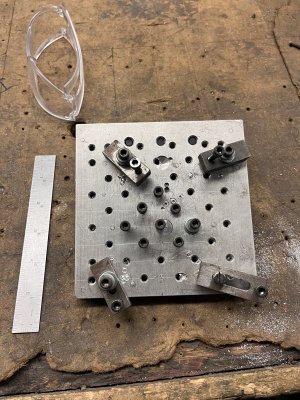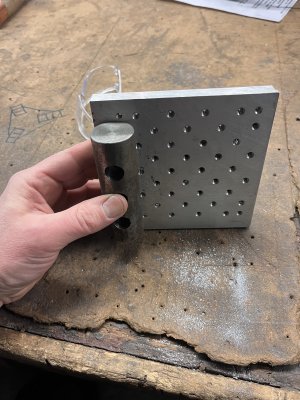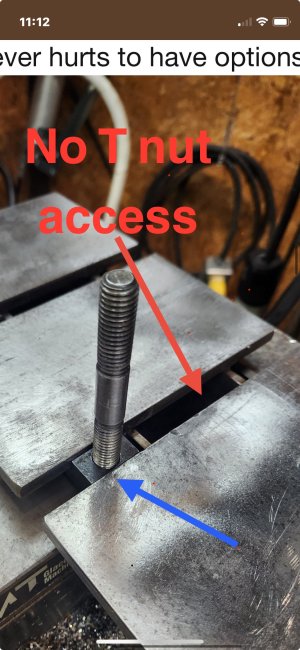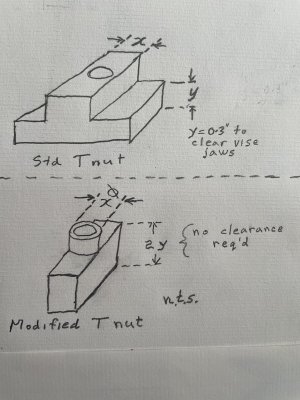Dan Dubeau
Ultra Member
Here a fixture plate I made today. I've had this Idea rolling around in my head for probably a decade, and finally had enough of a need for it that I built it. Nobody likes taking a vise off for a quick plate job, so the idea behind this is to have a "flat surface" I can toss in a vise whenever I need to do some "2d" work on a plate/flat part. A bunch of hold down holes, and enough of a ledge all the way around I can use a clamp whatever I need to hold. I sized this one to be used with both the 6" vise on my Manual mill, and the double 4" vises in the Tormach.
On with the pics......When I first thought of this idea, I was going to use 6" channel for the vise mount, but those 4" vises don't open that wide......So I found some 3" beam that I figured could work with some reinforcement. I was also going to use bolt on mic6 plates for the top, but I no longer have a never ending supply of mic6 offcuts, so that Idea was out. I used 4x7x3/8" plates instead.

Quick layout to see how it looks.

Cut some filler pieces from some 3/8" thick scrap, and milled them to the same thickness.



Layed them out where they will support both visesthe best and welded them in. When I do projects like this, I like to play around with stuff. Upper one I tried to hold a steady hand, the bottom one I did small circles. Never hurts to try stuff, and see how you like it. Did some other patterns on all the other welds too. I like the steady hand the best, I just wish I had one lol.

I let it cool down over lunch, then milled it all up square on all sides, and took it down about 0.3" in height (to 2.100"). Just high enough that a tee nut will clear the jaws on a 6" vise. Guess I didn't get any other pics of this process....


Once it was all squared up, I clamped up the top plates where I wanted them, using a 1.5 tube for a spacer, and welded them on the corners as I didn't want to warp the 3/8" thick plates. Also took some measurements so I could do a quick cad layout and program the holes.




Didn't notice this until posting these pics and looking at it on the screen, but it looks like those welds didn't penetrate in the middle and you can see a crack there between the supports. Took some head scratching to figure out why, but it's because while I DID weld them across the bottom, I also took about 0.075" off that side, so that would have machined off whatever weld was there anyway...had me worried about it for a second....
Left it to cool while I made dinner, then went back out and faced it down. Was expecting to see a bit of warp here, but 0.015" cleaned it up very nicely. This was also a bit of a rigidity test here, especially on the longer overhang, and I was surprised how goo it was. Only a tiny bit of chatter is perceptible in the finish compared to the more supported parts.

Here you can see I left the spacing at 5/8" so I can use stock tee nuts if I ever needed to. Never hurts to have options....

I also walked an EM all around it to square the edges up.

Now it was time to jump in the Tormach for hole drilling. The thought of drilling these by hand isn't my idea of a good time.....

I was more concerned about this fitting the work envelope of the Tormach because I'll probably use it the most here for profiling stuff from plate. That is the reason I needed to finally build it right now. With the double vice setup, I don't really want to take them off more than I have to to do flat stuff.

Spot drill

Drill #7

While the CNC was drilling, I jumped in the lathe to face off some bolts for spacers/standoffs. I have another idea for these that I can't wait to try tomorrow. It may, or May not work, we'll see.....


Then edited the spot program to chamfer the holes.

Then it was time to tap the holes. Trusty makita, a nice fresh 1/4"-20 spiral point tap, and some anchor lube. My first time using it. It's alright, did it's job I guess. I like that it stays put. I usually use rapid tap for steel, but can see anchor lube earning a spot in the lineup.

On with the pics......When I first thought of this idea, I was going to use 6" channel for the vise mount, but those 4" vises don't open that wide......So I found some 3" beam that I figured could work with some reinforcement. I was also going to use bolt on mic6 plates for the top, but I no longer have a never ending supply of mic6 offcuts, so that Idea was out. I used 4x7x3/8" plates instead.
Quick layout to see how it looks.
Cut some filler pieces from some 3/8" thick scrap, and milled them to the same thickness.
Layed them out where they will support both visesthe best and welded them in. When I do projects like this, I like to play around with stuff. Upper one I tried to hold a steady hand, the bottom one I did small circles. Never hurts to try stuff, and see how you like it. Did some other patterns on all the other welds too. I like the steady hand the best, I just wish I had one lol.
I let it cool down over lunch, then milled it all up square on all sides, and took it down about 0.3" in height (to 2.100"). Just high enough that a tee nut will clear the jaws on a 6" vise. Guess I didn't get any other pics of this process....
Once it was all squared up, I clamped up the top plates where I wanted them, using a 1.5 tube for a spacer, and welded them on the corners as I didn't want to warp the 3/8" thick plates. Also took some measurements so I could do a quick cad layout and program the holes.
Didn't notice this until posting these pics and looking at it on the screen, but it looks like those welds didn't penetrate in the middle and you can see a crack there between the supports. Took some head scratching to figure out why, but it's because while I DID weld them across the bottom, I also took about 0.075" off that side, so that would have machined off whatever weld was there anyway...had me worried about it for a second....
Left it to cool while I made dinner, then went back out and faced it down. Was expecting to see a bit of warp here, but 0.015" cleaned it up very nicely. This was also a bit of a rigidity test here, especially on the longer overhang, and I was surprised how goo it was. Only a tiny bit of chatter is perceptible in the finish compared to the more supported parts.
Here you can see I left the spacing at 5/8" so I can use stock tee nuts if I ever needed to. Never hurts to have options....
I also walked an EM all around it to square the edges up.
Now it was time to jump in the Tormach for hole drilling. The thought of drilling these by hand isn't my idea of a good time.....
I was more concerned about this fitting the work envelope of the Tormach because I'll probably use it the most here for profiling stuff from plate. That is the reason I needed to finally build it right now. With the double vice setup, I don't really want to take them off more than I have to to do flat stuff.
Spot drill
Drill #7
While the CNC was drilling, I jumped in the lathe to face off some bolts for spacers/standoffs. I have another idea for these that I can't wait to try tomorrow. It may, or May not work, we'll see.....
Then edited the spot program to chamfer the holes.
Then it was time to tap the holes. Trusty makita, a nice fresh 1/4"-20 spiral point tap, and some anchor lube. My first time using it. It's alright, did it's job I guess. I like that it stays put. I usually use rapid tap for steel, but can see anchor lube earning a spot in the lineup.
Last edited:






